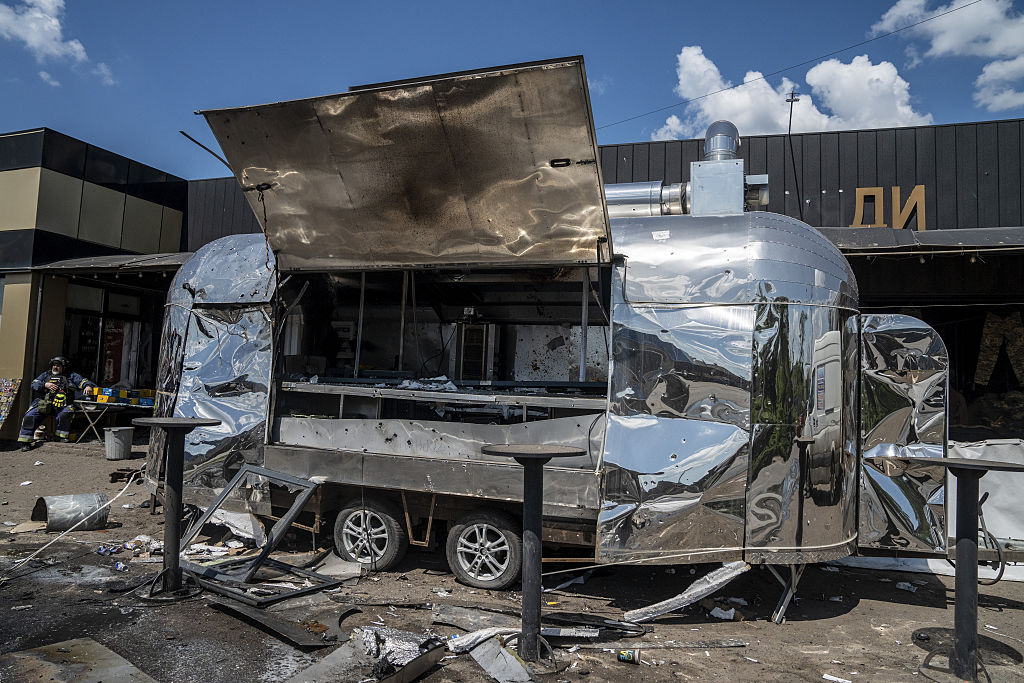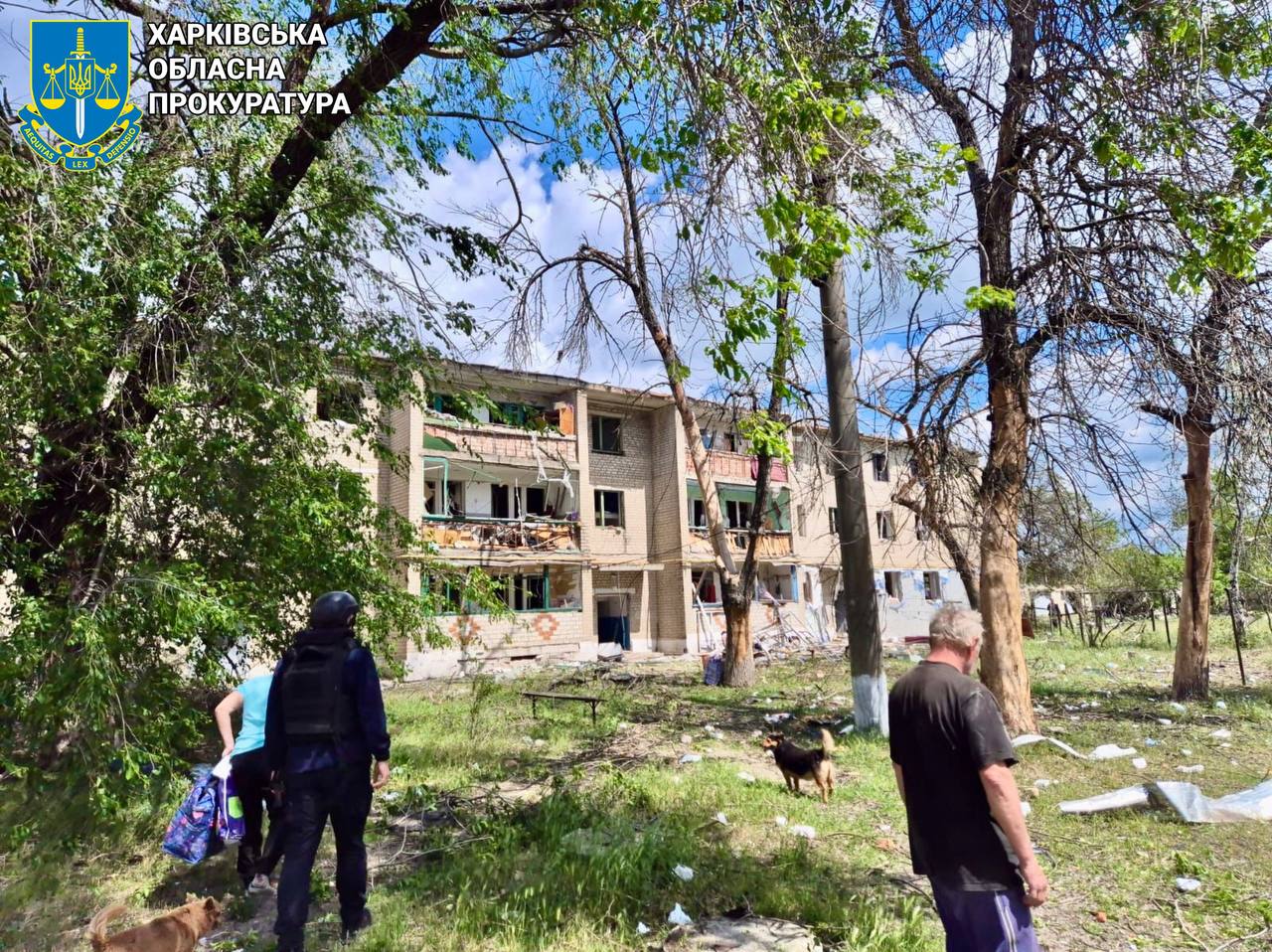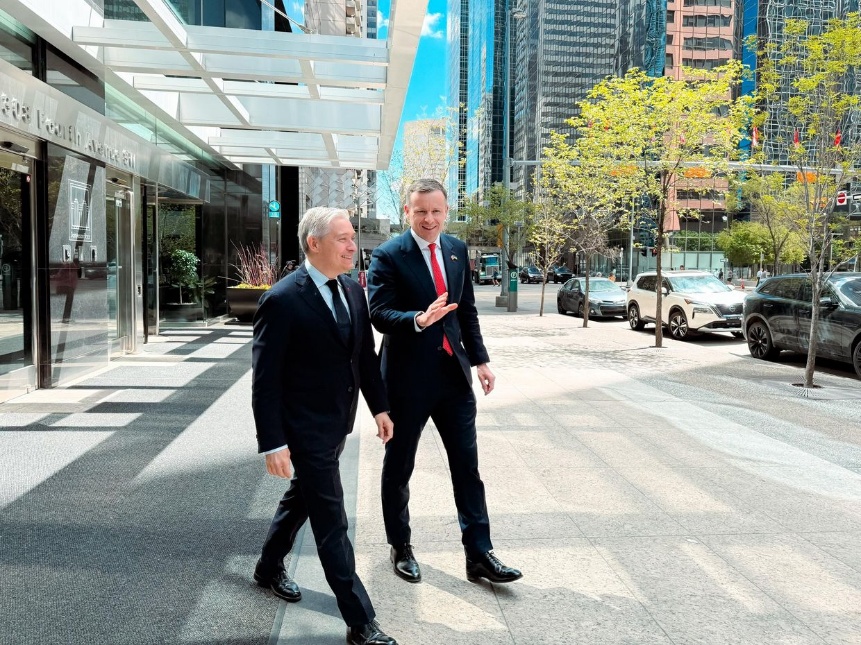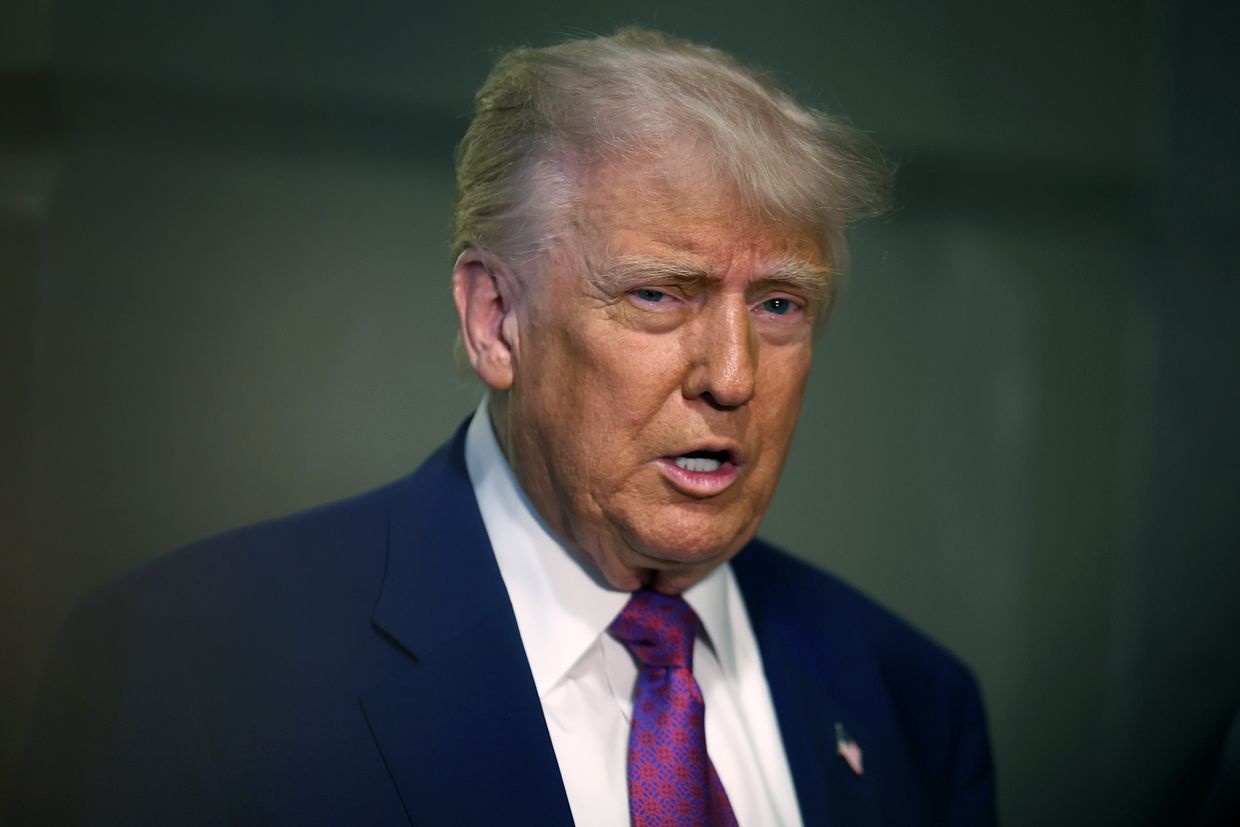As Putin Proclaims Buffer Zones and Rejects Peace, 485 Ukrainian Drones Strike Deep Into Russia While European Leaders Seek Vatican Summit for Elusive Ceasefire
Summary of the Day – May 22, 2025
In a day that crystallized the deepening chasm between rhetoric and reality, Vladimir Putin unveiled an emerging state ideology rooted in militant Russian nationalism while Ukrainian drones forced Moscow’s airports to shut down for the third consecutive night. As the Kremlin leader proclaimed the need for “buffer zones” along Ukraine’s border and formally rejected any ceasefire, U.S. President Donald Trump privately acknowledged to European leaders what they had long known: Putin believes he is winning and has no intention of ending the war. Meanwhile, Ukraine brought home nine more children from occupied territories, each carrying stories of basement imprisonments and years of terror, while the EU prepared its 18th sanctions package and Ukraine’s defense manufacturers pleaded for export permits to save their industry from collapse.

A view of destruction after Lancet drone strikes at a roadside cafe in Raihorodka, Lyman District, Donetsk Oblast. A 39-year-old resident who was selling at the market was injured and taken to hospital with a mine blast injury and shrapnel wounds while a 51-year-old kiosk vendor was killed. (Jose Colon/Anadolu via Getty Images)
The Nationalist Crusade: Putin Enshrines Opposition to the West in Emerging State Ideology
At a carefully choreographed award ceremony on May 22, Vladimir Putin laid bare the ideological foundations of a new Russian nationalism that positions eternal conflict with the West as a civilizational imperative. “Strong family foundations” and “traditional values” support Russia’s “1,000-year-old statehood,” Putin declared, emphasizing that Russia’s “most important” task is to preserve its people, culture, and spirituality.
The ceremony’s guest list revealed the doctrine’s contours: A Russian Orthodox priest—but no representatives of Islam, Judaism, or Buddhism, despite their official status as Russia’s “traditional” religions—thanked Putin for protecting Russian culture and noted that celebrations of World War II victory teach youth in the “Russkiy Mir” to defend Russia. State Historical Museum Director Alexei Levikin claimed hostile countries base their policies on “falsification of historical events,” while a martial arts school director asserted that Russia “always proves that its fighters are the best on the battlefields.”
This departure from Putin’s previous promotion of civic nationalism signals an attempt to appease the ultranationalist community while creating an ideological foundation for perpetual conflict. The development coincides with Putin’s declaration of 2025 as the “Year of the Defender of the Fatherland,” part of a broader effort to cultivate a militarized elite class that will ensure any successor embodies similarly aggressive ideals.
Constitutional Zealotry: Bastrykin Pushes to Enshrine Nationalist Ideology in Law
Russian Investigative Committee Head Alexander Bastrykin, one of the Kremlin’s most outspoken ultranationalists, seized on Putin’s ideological pivot to advocate for constitutional changes. In a May 22 interview with TASS, Bastrykin argued that traditional values—patriotism, citizenship, service to the Fatherland, and strong families—should underpin Russia’s “national idea” and be enshrined in the constitution.
The proposal sparked immediate discord within the Kremlin elite. While State Duma Deputy Speaker Pyotr Tolstoy had suggested on May 19 that Russia might change its constitution, Duma Committee Head Pavel Krasheninnikov countered that the document “meets current realities.” Kremlin Spokesperson Dmitry Peskov initially dismissed constitutional changes as “not on the agenda,” only to hedge on May 22 that it’s “difficult to comment” without specifics.
The timing is no coincidence. As the Kremlin accelerates promotion of this ideology to prepare the domestic population for future military conflict against the West, Bastrykin appears to be spearheading efforts to formalize what the current constitution explicitly forbids: a state ideology.
Denying History, Erasing Sovereignty: Russia Resurrects Soviet Dissolution Narrative
In a chilling echo of imperial ambitions, Russian officials renewed their years-long narrative rejecting the legality of the Soviet Union’s 1991 dissolution. State Duma Committee Head Nina Ostanina declared on May 22 that deputies are ready to raise the issue of the Soviet Union’s alleged continued legal existence, agreeing with Presidential Advisor Anton Kobyakov’s claim that the founding body wasn’t involved in the dissolution.
Ostanina went further, claiming that “no one gave authority” to the leaders of Belarus, Russia, and Ukraine to sign the December 1991 Belovezha Accords. This narrative, intermittently revived since 2014, aligns dangerously with the Kremlin’s ongoing efforts to de facto annex Belarus through the Union State framework and its consistent denial of Ukrainian sovereignty.
The resurrection of this information campaign, coupled with frequent invocations of the “trinity doctrine” suggesting Russians, Belarusians, and Ukrainians are a forcibly separated people, may be setting conditions for Russia to withdraw recognition of Ukraine and Belarus as independent states—though past iterations of this campaign have yielded no immediate effects.
The Legitimacy Game: Kremlin Questions Ukraine’s Right to Negotiate
Russian authorities escalated their campaign to delegitimize Ukraine’s government and negotiating team, laying groundwork to renege on any future peace agreement. Foreign Ministry Legal Department Director Maksim Musikhin told TASS on May 21 that Volodymyr Zelensky has “long” lost his legitimacy, creating “problems” with any agreements he might sign.
Musikhin reiterated false claims that only Ukraine’s Verkhovna Rada holds legitimate power, ignoring that Ukraine’s constitution explicitly prohibits elections during martial law. TASS amplified an anonymous source claiming Ukraine’s Istanbul delegation had a “shortage of politicians” and might include “spies” working for European states or the U.S.
These statements form part of Russia’s ongoing efforts to justify withdrawing from future peace agreements at will and support demands for regime change in Kyiv—a prerequisite for any Russian vision of “peace.”
485 Drones in Three Days: Ukraine’s Aerial Campaign Shuts Moscow’s Skies
Ukrainian drones forced a third consecutive night of chaos in Moscow as 105 drones, including 35 targeting the capital, prompted the closure of all four Moscow airports—Sheremetyevo, Vnukovo, Domodedovo, and Zhukovsky. The Defense Ministry claimed 485 Ukrainian drones were intercepted between May 20 and 22, with 159 destroyed in less than 24 hours on May 22 alone.
The attacks struck across Russia’s heartland: Tula Oblast Governor Dmitry Milyaev reported a drone crashing into an apartment building roof, while airports in Tambov and Vladimir joined Moscow’s in temporary shutdowns. Other drones targeted Oryol, Kursk, Belgorod, Kaluga, Voronezh, Lipetsk, Smolensk, and Bryansk oblasts.
According to Serhii Bratchuk, spokesperson for Ukraine’s Southern Defense Forces, the campaign serves multiple purposes: “Moscow is the biggest aviation hub in the Russian Federation. This is about the potential disintegration of Russian regions and the weakening of internal control.” Since January 1, Ukrainian drones have forced at least 217 temporary airport closures across Russia, surpassing the combined total for 2023 and 2024.
Buffer Zone Proclamations: Putin’s Admission of Permanent War
Vladimir Putin’s May 22 announcement that he had ordered creation of a “security buffer zone” along the border with Ukraine sent a clear message about Russia’s intentions. Speaking via video conference after his first known visit to Kursk Oblast since Moscow claimed to have retaken the region, Putin declared: “Our armed forces are currently solving this problem.”
The zone would encompass borders of Kursk, Bryansk, and Belgorod oblasts—a direct response to Ukraine’s successful cross-border operations that have persisted despite Russian claims of full territorial control. Ukrainian Foreign Minister Andrii Sybiha’s response was swift: “These new aggressive claims clearly reject peace efforts and show that Putin has been and remains the only reason the killing continues.”
Foreign Ministry Spokesperson Heorhii Tykhyi suggested an alternative: “As for the ‘buffer zones,’ there can be a ‘buffer zone’ on the territory of Russia, which is why Ukraine has been conducting an operation there since last year.”
The Vatican Gambit: Trump Proposes Papal Peace Summit Amid Russian Intransigence
Following his May 19 phone call with Putin, Donald Trump told European leaders that the next round of negotiations could take place at the Vatican in mid-June, with Secretary of State Marco Rubio and Special Envoy Keith Kellogg representing the United States. Italian Prime Minister Giorgia Meloni confirmed Pope Leo XIV’s willingness to host, though the Kremlin insisted no final decision had been made.
The proposal emerged from a revealing conversation where Trump privately acknowledged to European allies what they had long maintained: Putin is not ready for peace because he believes Russia is winning. According to the Wall Street Journal, this marked the first time Trump admitted this reality to European leaders, despite their “surprise” at his relatively content reaction to Putin’s rejection of ceasefire terms.
European leaders initially pushed for an “unconditional” ceasefire, but Trump objected to the wording—ironically, given his own previous use of the term. The contradiction underscores the diplomatic confusion surrounding peace efforts, with Russia’s Foreign Minister Sergey Lavrov virtually confirming Moscow’s disinterest: “We don’t want this anymore.”
Nine Children’s Liberation: Stories of Basements, Torture, and Three Years of Terror
Ukraine brought nine more children from Russian-occupied territories to safety on May 22, each carrying harrowing testimonies of occupation’s human cost. Among them: a girl whose life hung in balance due to lack of medical care; a boy locked in a basement with his mother while his father was tortured in the next room; two sisters who didn’t leave their home for nearly three years due to constant shelling and Russian tanks; a teenage girl cut off from education by communication blockades.
“These children lived through horrors,” said Presidential Office chief Andriy Yermak. The rescue, conducted through the Bring Kids Back UA initiative, adds to the 1,300 children returned from the over 19,500 identified as forcibly deported to Russia, Belarus, or occupied territories. Their return remains what Zelensky calls the “number one aim” in any peace negotiations.
War Crimes Documentation: Russian Commander Admits to Perfidy Tactics
In a potential admission of war crimes, Russian Major General Apti Alaudinov, Deputy Head of the Defense Ministry’s Main Military-Political Directorate, described to TASS how Russian forces used deception tactics that may constitute perfidy under the Geneva Convention. Alaudinov detailed using blue electrical tape—knowing Ukrainian forces use the same identification—to “prevent the Ukrainian military from understanding what was happening” and make them “think that their own units were advancing.”
The admission adds to mounting evidence of systematic violations. CNN reported on May 21 that a Ukrainian intelligence official provided drone footage and intercepted audio of a Russian commander ordering the execution of Ukrainian POWs near Novodarivka in November 2024. UN Special Rapporteur Morris Tidball-Binz told CNN such executions cannot occur at this frequency without orders or consent from the highest commanders, including Putin.
Ground Forces Command: Mordvichev Appointed to Proliferate Grinding Warfare Tactics
Defense Minister Andrei Belousov confirmed Colonel General Andrei Mordvichev’s appointment as Russian Ground Forces Commander on May 22, a move analysts interpret as intent to proliferate positional warfare tactics across Russia’s military. The appointment signals commitment to the grinding marginal advances that characterized Russian operations in the Avdiivka-Pokrovsk direction.
The Battlefield Grinds On: Incremental Advances Amid Strategic Stalemate
Across multiple fronts, the war’s grinding nature persisted with minimal territorial changes. Ukrainian forces recently advanced near Toretsk, with geolocated footage showing progress northwest of Druzhba. Russian forces made gains near Vovchansk in northeastern Kharkiv Oblast, west of Dyliivka north of Toretsk, and in the Velyka Novosilka direction north of Dniproenerhiya.

The aftermath of a Russian attack on Kupiansk-Vuzlovyi in Kharkiv Oblast. (Kharkiv Regional Prosecutor’s Office)
Ukraine’s Khortytsia Group of Forces reported destroying five of eight Russian motorcycles attacking near Mala Shapkivka, illustrating the small-scale nature of many assaults. A Ukrainian company commander in Kramatorsk noted Russian forces are varying tactics, using heavy vehicles, automobiles, and motorcycles in different combinations.
Finland Braces for Post-War Russian Buildup Along 1,300-Kilometer Border
Finnish defense forces strategy head Major General Sami Nurmi warned on May 21 that Russia has begun “moderate preparations” for infrastructure along the Finnish border, expecting a major military buildup once the Ukraine war ends. “They are doing it in phases,” Nurmi told The Guardian, noting construction of new infrastructure and equipment positioning.
The warning comes as Finland completes the first 35 kilometers of a planned 200-kilometer fence along its eastern border, closed for over a year due to Russian “hybrid operations.” Satellite images from May 19 show expanded military facilities near the border, though Trump dismissed concerns on May 20, saying Finland and Norway would remain “very safe.”
European Sanctions Intensify: Fertilizer Tariffs and Shadow Fleet Targeting
The European Parliament approved on May 22 massive tariff increases on Russian and Belarusian fertilizers and agricultural goods, with nitrogen fertilizer tariffs rising from 6.5% to 100% over three years—effectively halting trade. An additional 50% duty targets agricultural products worth €380 million annually.
Meanwhile, the EU readies its 18th sanctions package after the 17th round blacklisted 200 tankers in Russia’s “shadow fleet.” Commission President Ursula von der Leyen outlined plans to target the defunct Nord Stream pipelines, list more shadow fleet vessels, lower the oil price cap, and impose additional financial sector measures. Yet diplomats acknowledge growing difficulty in finding consensus, with Hungary’s potential veto looming over sanctions renewal.
Ukraine’s Defense Industry Pleads for Export Lifeline Amid Production Surplus
In an open letter to President Zelensky on May 22, Ukraine’s defense manufacturers urged lifting export restrictions on military-grade equipment, particularly drones, warning that companies face bankruptcy without access to global markets. The sector, which exploded to over 200 drone companies since 2022, can produce $20 billion in equipment but receives funding for only half.
“It is time to demonstrate that Ukraine is capable of being not only a party that receives international support, but also a full-fledged partner that exports security,” the letter states. Current regulations require permits from the State Export Service that producers call “nearly impossible to obtain,” blocking access to surging foreign demand just as European partners seek innovative defense solutions.
Financial Integration: Ukraine Proposes EU Defense Funding Model
Finance Minister Serhii Marchenko proposed on May 22 that the EU begin directly funding Ukraine’s armed forces starting in 2026, framing it as strengthening Europe’s collective defense. Under the proposal, European contributions would represent a small fraction of combined GDP and could count toward NATO spending targets.

Ukrainian Finance Minister Serhii Marchenko (right) walks with Canadian Minister of Innovation, Science and Industry Francois-Philippe Champagne during talks in Toronto, Canada. (Serhii Marchenko / Facebook)
“The Ukrainian army has all the experience necessary for this,” Marchenko said after G7 meetings in Canada. The proposal emerges as Ukraine faces continued financial challenges, having received $133 billion in international aid over three years to maintain stability and basic services.
Russian Economic Strain: Oil Price Collapse Forces Sweeping Budget Cuts
Plummeting oil revenues forced the Russian government to slash budgets across multiple sectors, Kommersant reported on May 22. With oil prices below $50 per barrel—40% lower than budgeted—the Kremlin cut aviation development by 22%, high-tech industries by 46 billion rubles, automotive by 35 billion rubles, and robotics production by nearly a third.
The cuts target programs aimed at replacing Western technology and boosting civilian production, revealing the strain of maintaining massive military expenditures amid sanctions targeting Russia’s shadow fleet and gas exports. Oil and gas revenues, accounting for 30% of Russia’s budget, remain crucial for funding the war.
Looking Ahead: A War Without End in Sight
As May 22 drew to a close, the day’s events painted a portrait of deepening entrenchment on all sides. Putin’s ideological pronouncements and buffer zone declarations signal preparation for perpetual conflict, while Ukraine’s drone campaign brings the war to Moscow’s doorstep. European leaders grapple with Trump’s recognition of Putin’s intransigence, yet press forward with Vatican summit plans that seem increasingly disconnected from battlefield realities.

President Donald Trump arrives for a House Republican meeting at the U.S. Capitol in Washington, DC. (Tasos Katopodis/Getty Images)
With Russia rejecting ceasefires, questioning Ukraine’s legitimacy, and constitutionalizing militant nationalism, while Ukraine strikes deeper into Russian territory and pleads for economic lifelines for its defense industry, the trajectory points not toward peace but toward a long war of attrition. The liberation of nine children serves as a poignant reminder of what hangs in the balance—not abstract territorial disputes, but the fate of thousands still trapped behind enemy lines, waiting for a homecoming that grows more distant with each passing day.
